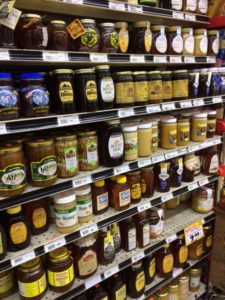 I went to my neighborhood grocery store the other day. I try to shop local whenever I can.
I went to my neighborhood grocery store the other day. I try to shop local whenever I can.
The store is fairly small (the parking lot holds less than 30 cars), but it always amazes me how well they satisfy the tastes of such an ethnically and culturally diverse clientele.
While not specifically on my shopping list, I found myself lingering at their floor to ceiling display of HONEY.
OMG. There were so many different kinds.
There are different types of honey based on source — like clover or wildflower or eucalyptus or alfalfa or buckwheat or orange blossom.
Honey can also be categorized by grade, reflecting color and water content, or by process. There is raw and pasteurized, filtered and strained.
When I looked at the jars and labels in the display, I also sensed a sort of boutique identification customers might have with certain brands.
In the honey world, small batch is cool. Limited distribution rules. I’m sure some aficionados look for honey manufactured by old hippies living in communes in Michigan or prepared at an Amish farm and carted off by horse-drawn wagon (eventually to be delivered by a diesel-powered truck to a grocery store).
Other types of the sweet golden condiment boast of an ethnic heritage and the foods they are best suited for. As example, there are brands that are purchased specifically for Greek or Mexican or Indian desserts.
Mostly contained in fancy glass jars, indicating purity, packaging for honey has come a long way since the days of plastic Pooh-Bear squeeze bottles.
Friday night, I joined several friends for a movie and a pizza. We went to a pizzeria by the theater where none of us had been before. It featured coal-fired pizza.
In Chicago, a town with a longstanding pizza tradition, I thought I had sampled every type of pizza there was.
I had favorite spots for thin or pan or stuffed. I could feast on vegetarian or meaty. I even have sampled ‘za with caramelized cheese edges, but coal-fired was new to me.
With extra fresh herbs and spices, it turned out to be very good. We all wanted to come back and try other combinations of ingredients.
Infinite variety makes me think about infinite possibilities.
These days, I’ve been getting upset over people who are afraid of immigrants, afraid of anything that’s different. They’re very easy prey for politicians or media personalities to stir up fear in them.
They probably don’t think much about the lesson of multi-tiered shelves of honey (or cereal or chips) at their grocery store. They probably are numb to getting a similar lesson when they take a walk. There’s an incredible variety of things, of grasses and leaves and animals, in nature.
Infinite variety leads to infinite possibilities.
I know that I want to live my life believing in possibilities.
Except for different strains of Ebola viruses, infinite possibilities is usually a good thing.
I am glad my mind is tuned up to notice these kinds of lessons all the time. Living with an open and inquisitive mind leads me to make conscious and informed choices all the time regarding how I want to live going forward.
Seeing lessons or having your world view validated in the simple activities of daily life is no small thing.


Leave a comment